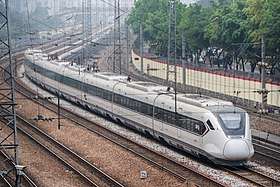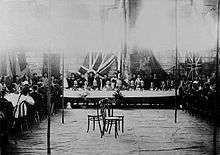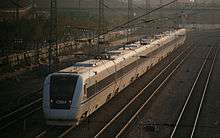Guangzhou–Shenzhen railway
Guangshen railway or Guangzhou–Shenzhen railway (Chinese: 广深铁路 or 广深线), also known as the Chinese section of the Kowloon–Canton railway (廣九鐵路華段) in 1911–1949, is a railway in Guangdong province in the People's Republic of China, between Guangzhou and Shenzhen. It is operated by Guangshen Railway Co., Ltd., a publicly traded company.
| Guangzhou–Shenzhen railway | |||||||||||||||||||||||||||||||||||||||||||||||||||||||||||||||||||||||||||||||||||||||||||||||||||||||||||||||||||||||||||||||||||||||||||||||||||||||||||||||||||||||||||||||||||||||||||||||||||||||||||||||||||||||||||||||||||||||||||||||||||||||||||||||||||||||||||||||||||||
|---|---|---|---|---|---|---|---|---|---|---|---|---|---|---|---|---|---|---|---|---|---|---|---|---|---|---|---|---|---|---|---|---|---|---|---|---|---|---|---|---|---|---|---|---|---|---|---|---|---|---|---|---|---|---|---|---|---|---|---|---|---|---|---|---|---|---|---|---|---|---|---|---|---|---|---|---|---|---|---|---|---|---|---|---|---|---|---|---|---|---|---|---|---|---|---|---|---|---|---|---|---|---|---|---|---|---|---|---|---|---|---|---|---|---|---|---|---|---|---|---|---|---|---|---|---|---|---|---|---|---|---|---|---|---|---|---|---|---|---|---|---|---|---|---|---|---|---|---|---|---|---|---|---|---|---|---|---|---|---|---|---|---|---|---|---|---|---|---|---|---|---|---|---|---|---|---|---|---|---|---|---|---|---|---|---|---|---|---|---|---|---|---|---|---|---|---|---|---|---|---|---|---|---|---|---|---|---|---|---|---|---|---|---|---|---|---|---|---|---|---|---|---|---|---|---|---|---|---|---|---|---|---|---|---|---|---|---|---|---|---|---|---|---|---|---|---|---|---|---|---|---|---|---|---|---|---|---|---|---|---|---|---|---|---|---|---|---|---|---|---|---|---|---|---|---|---|---|
 | |||||||||||||||||||||||||||||||||||||||||||||||||||||||||||||||||||||||||||||||||||||||||||||||||||||||||||||||||||||||||||||||||||||||||||||||||||||||||||||||||||||||||||||||||||||||||||||||||||||||||||||||||||||||||||||||||||||||||||||||||||||||||||||||||||||||||||||||||||||
 CRH6A at Guangzhou-Shenzhen Railway in Guangzhou in March 2018 | |||||||||||||||||||||||||||||||||||||||||||||||||||||||||||||||||||||||||||||||||||||||||||||||||||||||||||||||||||||||||||||||||||||||||||||||||||||||||||||||||||||||||||||||||||||||||||||||||||||||||||||||||||||||||||||||||||||||||||||||||||||||||||||||||||||||||||||||||||||
| Overview | |||||||||||||||||||||||||||||||||||||||||||||||||||||||||||||||||||||||||||||||||||||||||||||||||||||||||||||||||||||||||||||||||||||||||||||||||||||||||||||||||||||||||||||||||||||||||||||||||||||||||||||||||||||||||||||||||||||||||||||||||||||||||||||||||||||||||||||||||||||
| Native name | 广深铁路 广深线 | ||||||||||||||||||||||||||||||||||||||||||||||||||||||||||||||||||||||||||||||||||||||||||||||||||||||||||||||||||||||||||||||||||||||||||||||||||||||||||||||||||||||||||||||||||||||||||||||||||||||||||||||||||||||||||||||||||||||||||||||||||||||||||||||||||||||||||||||||||||
| Type | Higher-speed rail | ||||||||||||||||||||||||||||||||||||||||||||||||||||||||||||||||||||||||||||||||||||||||||||||||||||||||||||||||||||||||||||||||||||||||||||||||||||||||||||||||||||||||||||||||||||||||||||||||||||||||||||||||||||||||||||||||||||||||||||||||||||||||||||||||||||||||||||||||||||
| Status | Operational | ||||||||||||||||||||||||||||||||||||||||||||||||||||||||||||||||||||||||||||||||||||||||||||||||||||||||||||||||||||||||||||||||||||||||||||||||||||||||||||||||||||||||||||||||||||||||||||||||||||||||||||||||||||||||||||||||||||||||||||||||||||||||||||||||||||||||||||||||||||
| Locale | Guangzhou Dongguan Shenzhen | ||||||||||||||||||||||||||||||||||||||||||||||||||||||||||||||||||||||||||||||||||||||||||||||||||||||||||||||||||||||||||||||||||||||||||||||||||||||||||||||||||||||||||||||||||||||||||||||||||||||||||||||||||||||||||||||||||||||||||||||||||||||||||||||||||||||||||||||||||||
| Termini | Guangzhou Shenzhen | ||||||||||||||||||||||||||||||||||||||||||||||||||||||||||||||||||||||||||||||||||||||||||||||||||||||||||||||||||||||||||||||||||||||||||||||||||||||||||||||||||||||||||||||||||||||||||||||||||||||||||||||||||||||||||||||||||||||||||||||||||||||||||||||||||||||||||||||||||||
| Stations | 22 | ||||||||||||||||||||||||||||||||||||||||||||||||||||||||||||||||||||||||||||||||||||||||||||||||||||||||||||||||||||||||||||||||||||||||||||||||||||||||||||||||||||||||||||||||||||||||||||||||||||||||||||||||||||||||||||||||||||||||||||||||||||||||||||||||||||||||||||||||||||
| Line number | 4 | ||||||||||||||||||||||||||||||||||||||||||||||||||||||||||||||||||||||||||||||||||||||||||||||||||||||||||||||||||||||||||||||||||||||||||||||||||||||||||||||||||||||||||||||||||||||||||||||||||||||||||||||||||||||||||||||||||||||||||||||||||||||||||||||||||||||||||||||||||||
| Operation | |||||||||||||||||||||||||||||||||||||||||||||||||||||||||||||||||||||||||||||||||||||||||||||||||||||||||||||||||||||||||||||||||||||||||||||||||||||||||||||||||||||||||||||||||||||||||||||||||||||||||||||||||||||||||||||||||||||||||||||||||||||||||||||||||||||||||||||||||||||
| Opened | 8 October 1911 | ||||||||||||||||||||||||||||||||||||||||||||||||||||||||||||||||||||||||||||||||||||||||||||||||||||||||||||||||||||||||||||||||||||||||||||||||||||||||||||||||||||||||||||||||||||||||||||||||||||||||||||||||||||||||||||||||||||||||||||||||||||||||||||||||||||||||||||||||||||
| Owner | China Railway | ||||||||||||||||||||||||||||||||||||||||||||||||||||||||||||||||||||||||||||||||||||||||||||||||||||||||||||||||||||||||||||||||||||||||||||||||||||||||||||||||||||||||||||||||||||||||||||||||||||||||||||||||||||||||||||||||||||||||||||||||||||||||||||||||||||||||||||||||||||
| Operator(s) | Guangshen Railway Co., Ltd. | ||||||||||||||||||||||||||||||||||||||||||||||||||||||||||||||||||||||||||||||||||||||||||||||||||||||||||||||||||||||||||||||||||||||||||||||||||||||||||||||||||||||||||||||||||||||||||||||||||||||||||||||||||||||||||||||||||||||||||||||||||||||||||||||||||||||||||||||||||||
| Rolling stock | CRH1A EMU (Guangshen intercity train) | ||||||||||||||||||||||||||||||||||||||||||||||||||||||||||||||||||||||||||||||||||||||||||||||||||||||||||||||||||||||||||||||||||||||||||||||||||||||||||||||||||||||||||||||||||||||||||||||||||||||||||||||||||||||||||||||||||||||||||||||||||||||||||||||||||||||||||||||||||||
| Technical | |||||||||||||||||||||||||||||||||||||||||||||||||||||||||||||||||||||||||||||||||||||||||||||||||||||||||||||||||||||||||||||||||||||||||||||||||||||||||||||||||||||||||||||||||||||||||||||||||||||||||||||||||||||||||||||||||||||||||||||||||||||||||||||||||||||||||||||||||||||
| Line length | 147 km (91.342 mi) | ||||||||||||||||||||||||||||||||||||||||||||||||||||||||||||||||||||||||||||||||||||||||||||||||||||||||||||||||||||||||||||||||||||||||||||||||||||||||||||||||||||||||||||||||||||||||||||||||||||||||||||||||||||||||||||||||||||||||||||||||||||||||||||||||||||||||||||||||||||
| Number of tracks | 4 | ||||||||||||||||||||||||||||||||||||||||||||||||||||||||||||||||||||||||||||||||||||||||||||||||||||||||||||||||||||||||||||||||||||||||||||||||||||||||||||||||||||||||||||||||||||||||||||||||||||||||||||||||||||||||||||||||||||||||||||||||||||||||||||||||||||||||||||||||||||
| Track gauge | 1,435 mm (4 ft 8 1⁄2 in) | ||||||||||||||||||||||||||||||||||||||||||||||||||||||||||||||||||||||||||||||||||||||||||||||||||||||||||||||||||||||||||||||||||||||||||||||||||||||||||||||||||||||||||||||||||||||||||||||||||||||||||||||||||||||||||||||||||||||||||||||||||||||||||||||||||||||||||||||||||||
| Electrification | Catenary (25 kV AC 50 Hz AC) | ||||||||||||||||||||||||||||||||||||||||||||||||||||||||||||||||||||||||||||||||||||||||||||||||||||||||||||||||||||||||||||||||||||||||||||||||||||||||||||||||||||||||||||||||||||||||||||||||||||||||||||||||||||||||||||||||||||||||||||||||||||||||||||||||||||||||||||||||||||
| Operating speed | 200 km/h (120 mph) (tracks 1 and 2) 140 km/h (87 mph) (tracks 3 and 4) | ||||||||||||||||||||||||||||||||||||||||||||||||||||||||||||||||||||||||||||||||||||||||||||||||||||||||||||||||||||||||||||||||||||||||||||||||||||||||||||||||||||||||||||||||||||||||||||||||||||||||||||||||||||||||||||||||||||||||||||||||||||||||||||||||||||||||||||||||||||
| |||||||||||||||||||||||||||||||||||||||||||||||||||||||||||||||||||||||||||||||||||||||||||||||||||||||||||||||||||||||||||||||||||||||||||||||||||||||||||||||||||||||||||||||||||||||||||||||||||||||||||||||||||||||||||||||||||||||||||||||||||||||||||||||||||||||||||||||||||||
| Guangshen Railway | |||||||||||||||
|---|---|---|---|---|---|---|---|---|---|---|---|---|---|---|---|
| Simplified Chinese | 广深铁路 | ||||||||||||||
| Traditional Chinese | 廣深鐵路 | ||||||||||||||
| |||||||||||||||
| Kowloon–Canton railway, Chinese section | |||||||||||||||
| Simplified Chinese | 广九铁路华段 | ||||||||||||||
| Traditional Chinese | 廣九鐵路華段 | ||||||||||||||
| |||||||||||||||
With a length of 147 kilometres, it was the first railway in the People's Republic of China to reach the speed of 220 km/h in some sections, though it is limited to about 180 km/h during commercial operation. Now it has four tracks between Guangzhou East and Shenzhen railway station. Line 1 and 2 are up-direction and down-direction 200-km/h (currently restricted to 180 km/h in operation) passenger lines for CRH EMU respectively, and Line 3 and 4 are up-direction and down-direction 160-km/h (currently restricted to 140 km/h in operation) mixed passenger and freight line respectively. In order to reduce the interference to passenger trains in the daytime from lower-speed freight trains, most freight trains will be scheduled to run at night.
Guangshen railway connects with several other important railways to different directions. It links Jingguang railway and Guangmao railway in Guangzhou, Jingjiu railway in Dongguan (with which shares two regular speed track), and the East Rail Line to Hong Kong at the southern end of the railway. Besides, there are some branch lines along Guangshen Railway, such as Pingyan railway to Yantian Port, Pingnan railway to Shenzhen West railway station and also the line to Huangbu Port.
Cross-border services from Hong Kong to Dongguan (Changping), Guangzhou East, Foshan and Zhaoqing, as well as to Beijing West and Shanghai use its route.
History
The idea of constructing a railway linking Canton (now Guangzhou) and Kowloon in Hong Kong, a British crown colony germinated in the late Qing dynasty. In 1899, Britain and the Qing government agreed to construct the Kowloon–Canton railway (KCR, also known as Canton-Kowloon Railway), but Britain postponed the construction as Britain was busy at the Second Boer War in Africa. In 1907, Qing government and Britain formally signed an agreement in Peking on issuing a £100-million bond as part of loan for the construction of the Chinese section of the Kowloon–Canton railway. In July 1907, construction of the British Section of the KCR began. The construction of Chinese section was delayed and only started in 1909. Under the loan contract, China needed to employ the British engineers for the construction of Chinese section, but China still employed famous Chinese railway engineers, Zhan Tianyou, as a consultant. On 8 October 1911, the Chinese section of KCR with total length of 142.77 km (88.71 mi)was opened.[1] The northern end of railway at that time was located in Dashatou (大沙頭), Guangzhou, where was demolished in 1951. The through train service between Kowloon and Guangzhou also started to operate at the same time.
After the establishment of People's Republic of China in October 1949, the 'Chinese section of the Canton–Kowloon railway' was renamed 'Guangshen railway', and repair the railroad damaged during the war. In 1967, railway department carried out a comprehensive maintenance on Guangshen railway to improve the transport capacity. From 1980s, since the economic reform policy of China, the Shenzhen Special Economic Zone was established. The rapid economic development in the Pearl River Delta region brought large amount of importing goods and passengers to the railway. Therefore, the second line of Guangshen Railway was constructed during 1984–1987 in order to meet the huge demand. Simultaneously Guangshen Railway Company (the predecessor of Guangshen Railway Company), which was directly subordinated to the Guangzhou Railway Bureau (now Guangzhou Railway Group), was established. This company was in charge of the construction works and operational management of Guangshen Railway. In 1987, Guangshen railway became the first double-track railway in Guangdong province.

Image gallery
- Bond agreement signed in 1907
 Foundation ceremony of the Chinese Section of KCR in 1909. Group photo of both Chinese and British officials.
Foundation ceremony of the Chinese Section of KCR in 1909. Group photo of both Chinese and British officials.
Indeed, Guangshen railway is the first place in China to carry out successfully speed-up on the existing railroad. At the beginning of the 1990s, Guangzhou Railway Bureau and the Ministry of Railways carried out the pre-feasibility research about raising the maximum speed of passenger trains to 160 km/h. At 28 December 1991, the construction of the third line of Guangshen railway, and the speed-up improvement works of original double tracks started. In October 1994, the maximum speed of a train reached 174 km/h during the test. At 22 December 1994, the first sub-high speed (160 km/h) passenger train in China started commercial operation between Guangzhou and Shenzhen.

In 1998, the electrification of two sub-high speed lines of Guangshen railway was finished. After the improvement the 200 km/h high speed trains are allowed to run on the existing subhigh speed railroad. A Swedish-built X 2000 tilting train called 'Xinshisu' began to serve intercity train service between Guangzhou and Shenzhen, as well as the through train to Hong Kong. The train are 165m long, consisting of a power car, five passenger cars, and a trailing car. The non-power cars can have a pitch of up to 8 degrees. They are noted for being very quiet (less than 65 dBA) even at 200 km/h.
Construction of the fourth track was commenced at 31 December 2005, and was finished at 18 April 2007 in time for the Sixth Speed-Up Campaign. Since then Guangshen railway has been the first four-track railway in mainland China and it allows passenger trains and freight trains to run on separate lines.
Guangshen intercity trains


As of 2007, intercity train service between Guangzhou and Shenzhen uses 8-car CRH1A highspeed EMU. There are 100 pairs of trains operated daily, in which 98 pairs will stop for 1.5 minutes at three stations: Zhangmutou, Dongguan and Shilong. On the 'As-frequent-as-buses' basis, one pair of trains is dispatched every 5 minutes on average during peak hours. The fastest journey time is 52 minutes between Guangzhou East and Shenzhen for D7002 and D7008 with no stop.
Rolling stock
| Time | Rolling stocks using by Guangshen intercity trains |
|---|---|
| Before 1966 | SL6 steam locomotive hauling 21 Series / 22 Series railway carriages |
| 1966–mid-1970s | SL6 steam locomotive / Dongfanghong1 / DF diesel locomotive (from 1972) hauling 21 Series / 22 Series railway carriage Dongfanghong1 / DF diesel locomotive(from 1972) hauling 24 Series railway carriages with air-conditioning (91/92 Express) |
| 1970s–late 1994 | Locomotives: DF3 / ND2 / DF4B (from 1985) / DF9 diesel locomotive(from 1990s) Passenger coaches: 24 Series with air-conditioning / 25 Series / 22 Series / 22 Series railway carriages with air-conditioning |
| Late 1994–1998 | Locomotives:DF4B / DF9 / DF11 diesel locomotive Passenger coaches:22 Series / Double-deck 25B Series with air-conditioning / 25Z Series |
| 1998–2004 | DF4B diesel locomotive hauling 22 Series / Double-deck 25B Series with air-conditioning / SS8 electric locomotive / DF11 diesel locomotive hauling 25Z Series / 25C Series railway carriage DDJ1 EMU(1999–2000) Xianfenghao EMU(2001) X2000 tilting train DJJ1 EMU (Blue Arrow)(from 2001) |
| 2004–2006 | DF4B diesel locomotive hauling Double-deck 25B Series with air-conditioning / SS8 electric locomotive / DF11 diesel locomotive hauling 25Z Series / 25C Series railway carriage X2000 tilting train / DJJ1 EMU (Blue Arrow) |
| 2007– | DF11 diesel locomotive hauling 25Z Series railway carriage (Until 25 April 2007) DF4B diesel locomotive hauling Double-deck 25B Series with air-conditioning (Until 30 June 2007) DJJ1 EMU (Blue Arrow) (Until 25 April 2007) CRH1A EMU (from 1 February 2007) |
Stations
Stations with services
Most of the stations on the line are now abandoned for passenger service. Currently, the only stations on the line offering passengers service are, in order:
| Station No. |
Station Name | Chinese | Distance km |
PRD MIR (CR C-train) transfers/connections |
Metro transfers/connections |
Location | ||||
|---|---|---|---|---|---|---|---|---|---|---|
| GZQ | Guangzhou | 广州 | 0 | 0 | GFZ * GQ | Yuexiu | Guangzhou | |||
| GGQ | Guangzhou East Guangzhoudong |
广州东 | 8 | 8 | SS * | Tianhe | ||||
| RTQ | Dongguan | 东莞 | 64 | 72 | Shilong | Dongguan | ||||
| DAQ | Changping | 常平 | 18 | 90 | Changping | |||||
| ZOQ | Zhangmutou | 樟木头 | 13 | 103 | Zhangmutou | |||||
| PHQ | Pinghu | 平湖 | 24 | 127 | Longgang | Shenzhen | ||||
| BJQ | Shenzhen East Shenzhendong |
深圳东 | 12 | 139 | ||||||
| SZQ | Shenzhen | 深圳 | 8 | 147 | Luohu | |||||
All existing stations
| Existing stations | ||||||||
|---|---|---|---|---|---|---|---|---|
Station Name English |
Station Name Chinese |
Total Distance |
Transfer |
Location |
Grade |
Notes | ||
| ● | ● | Guangzhou | 广州 | 0 | Yuexiu, Guangzhou | T [note 1] |
The departure station for minor Guangzhou – Shenzhen intercity trains (CRH) | |
| | | | | 云麓 | 4 | 4 | Not for passenger service. Decommissioned in 2009. | |||
| ● | ● | Guangzhou East | 广州东 | 8 | Tianhe, Guangzhou | 1 | The stop and departure station for all Guangzhou–Shenzhen intercity trains (CRH) | |
| | | ● | Shipai | 石牌 | 14 | 4 | Not for passenger service. | ||
| | | | | Huangpu | 黄埔 | 18 | 2 | Not for passenger service. | ||
| | | | | 九运会 | Decommissioned in 2002. | |||||
| | | ● | Jishan | 吉山 | 20 | 3 | Not for passenger service. | ||
| ● | ● | Xiayuan | 下元 | 27 | Huangpu, Guangzhou | 3 | Not for passenger service. | |
| | | | | 南岗 | 32 | 4 | Decommissioned in 2009. | |||
| | | ● | Xintang | 新塘 | 39 | Zengcheng, Guangzhou | 4 | Not for passenger service. | |
| | | | | 沙浦 | 45 | 5 | Decommissioned in 2007. | |||
| | | | | 塘美 | 4 | Decommissioned in 2007. | ||||
| ● | ● | Xiancun | 仙村 | 51 | 4 | Not for passenger service. | ||
| | | | | 石滩 | 60 | 4 | Decommissioned in 2009. | |||
| | | | | 红海 | 64 | 4 | Not for passenger service. Decommissioned in 2006. | |||
| | | | | 石龙 | 69 | Shilong, Dongguan | 3 | Decommissioned in 2014. | ||
| ● | ● | Dongguan | 东莞 | 72 | 2 | Stopping station for all Guangzhou–Shenzhen intercity trains (CRH) | ||
| | | ● | Chashan | 茶山 | 75 | Chashan, Dongguan | 4 | Not for passenger service. | |
| | | | | 南社 | 78 | 4 | Decommissioned in 2007. | |||
| | | | | 横沥 | 84 | Hengli, Dongguan | 4 | Decommissioned in 2009. | ||
| ● | ● | Changping | 常平 | 90 | Changping, Dongguan | 2 | Stopping station for all Guangzhou–Shenzhen intercity trains (CRH) | |
| | | | | 土塘 | 94 | 5 | Decommissioned | |||
| ● | ● | Zhangmutou | 樟木头 | 103 | Zhangmutou, Dongguan | 3 | Stopping station for all Guangzhou–Shenzhen intercity trains (CRH) | |
| | | | | 林村 | Tangxia, Dongguan | 4 | Decommissioned in 2010. | |||
| ● | ● | Tangtouxia | 塘头厦 | 114 | 4 | Not for passenger service. | ||
| | | | | 石鼓 | 119 | 4 | Decommissioned in 2007. | |||
| | | | | 天堂围 | 122 | Fenggang, Dongguan | 4 | Decommissioned in 2007. | ||
| ● | ● | Pinghu | 平湖 | 127 | Longgang, Shenzhen | 4 | Stopping station for some Guangzhou–Shenzhen intercity trains (CRH) | |
| | | ● | Pinghu South | 平湖南 | 131 | Not for passenger service. | |||
| | | | | 李朗 | 4 | Decommissioned in 2007. | ||||
| ● | ● | Shenzhen East | 深圳东 | 139 | 3 | Departure station for some non-high-speed trains. Intercity trains do not stop here. | ||
| ● | ● | Sungang | 笋岗 | 144 | Luohu, Shenzhen | 1 | Not for passenger service. | |
| ● | ● | Shenzhen | 深圳 | 147 | 1 | The departure station for all Guangzhou–Shenzhen intercity trains (CRH) | ||
| ↓ Through-service to/from Hung Hom (Kowloon) via East Rail Line ↓ | ||||||||
Cross-Line Traffic
There are services of EMUs using Guangzhou–Shenzhen railway as part of the route. 12 daily trains are offered between Guangzhou East Railway Station and Chaoshan Railway Station, one of which will continue to Xiamen. Starting 10 July 2019, there will also be a daily service between Shenzhen Railway Station and Huaiji Railway Station on Guiyang-Guangzhou HSR.[2]
See also
| Wikimedia Commons has media related to Guangzhou-Shenzhen Railway. |
- China Railway
- List of railways in China
- Rail transport in the People's Republic of China
- Kowloon–Canton railway
- Guangzhou–Shenzhen–Hong Kong Express Rail Link
References
- "Canton-Kowloon Chinese Railway 5% Loan – 1938". Archived from the original on 1 December 2008. Retrieved 23 June 2009.
- "深圳站7月将开行第一对跨线动车组列车(深圳到肇庆怀集) – 深圳本地宝". jt.sz.bendibao.com. Retrieved 18 August 2019.
- Top class; Chinese: 特等站